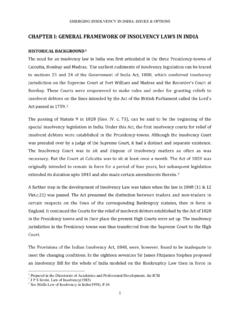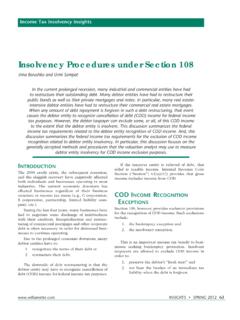Transcription of Contractor and subcontractor insolvency
1 Contractor and subcontractor insolvency January 2010 1 Early warning signs: what sort of behaviour or warning signs might indicate a Contractor beginning to get into trouble? The Contractor 's employees not turning up for work or a general decrease in the amount of labour on site. A slow-down in progress of the works. Plant, equipment and materials "disappearing" from site. An increase in the number of defects to the works. The Contractor seeking to negotiate further payments or release of the retention, or any other change in payment patterns (such as an advance payment or more frequent instalments or certificates). The Contractor raising spurious or unjustified claims or contra-charges to increase the amount payable to it. The Contractor assigning (or seeking the employer's consent to assign) the proceeds of the building contract to a bank or other creditor. If the Contractor is a company, late filing of accounts or annual returns with the relevant authorities, or auditor's reports that are signed off subject to a qualification (depending on the nature of the qualification).
2 Unsatisfied court judgments against the Contractor . These may be revealed by a business information report on the Contractor from a specialist business information provider, such as Dun & Bradstreet. Sub-contractors not being paid. Persistent rumours about the Contractor 's financial position in the press and from other sources. An underlying trend in the Contractor 's behaviour that suggests it is in financial difficulty. The Contractor 's parent company (or other companies in the same group as the Contractor ) displaying any of the warning signs listed in this note. 2 What can be done to protect the position if the warning signs are spotted Check that all bank bonds and parent company guarantees are in place. If not, the employer should take steps to obtain any missing parent company guarantees or bank bonds. Check whether the employer will be able to call any bonds in its favour or make a claim under a parent company guarantee.
3 This includes checking any technical requirements about the way in which the claim must be notified to the bondsman or guarantor. The employer should carefully consider if the bonds provide for a right to make a claim on the occurrence of an insolvency event without first having to obtain the decision of an adjudicator or a decision in any other form of dispute resolution. If the decision of an adjudicator is required, adjudication proceedings must be instigated prior to the date of the insolvency type event to avoid insolvency law implications. If more protracted proceedings are required, consider whether there will be time to obtain a decision in advance of the insolvency occurring. Ensure that the Employer is familiar with the terms of any parent company guarantee and check that the guarantor's obligations will not be discharged by: (a) Terminating the Contractor 's employment under the building contract.
4 (b) Renegotiating the scope of works with the Contractor or varying the underlying building contract without first obtaining the guarantor's consent. (Consider whether this would extend to any agreement to make direct payments to sub-contractors.) (c) Reaching a settlement with the Contractor . (d) Employing a new Contractor if the guarantor has a duty to complete the works. Closely monitor the Contractor s performance (including the financial performance of the Contractor and any guarantor). Agreements with third parties Check that all necessary collateral warranties have been procured in accordance with the terms of the contract. If not, it should take steps to obtain any missing collateral warranties. If third party rights are being granted instead of collateral warranties (under the Contracts (Rights of Third Parties) Act 1999), check that all notices granting third party rights have been issued.
5 Check that the employer will not breach any third party agreements if it terminates the Contractor 's employment without that third party's consent. For example, under a facility agreement, before the employer terminates the Contractor 's employment it usually needs the bank's consent. It is likely that the Contractor entering into administration or becoming insolvent will be an event of default under the facility agreement in any event. Protecting the site Ensure legal protection by checking that all insurance cover required by the construction contract is in place. Ensure physical protection by making arrangements for site security, to ensure plant, equipment and materials do not "disappear . Securing material and documents Check whether the employer has rights over design and copyright relating to the project, and that the employer obtains copies of any drawings or documents that are not already in its possession.
6 Secure off-site plant, equipment and materials (to the extent possible). Undertake an audit of on-site plant, equipment and materials. Payment Establish the precise amount already paid to the Contractor . This enables the employer to check whether: (a) the Contractor has been overpaid; or (b) a retention has been deducted from payments due to the Contractor (and when the retention has to be released). Check whether there is a right to set-off over-payments under the construction contract against other amounts payable to the Contractor . (a) at law or in equity; (b) contractually, under the construction contract or other agreements between the employer and the Contractor ; and (c) in case of a liquidation or administration in England, under the insolvency Act 1986 and the insolvency Rules 1986 (SI 1986/1925). (Note that there is no automatic right to set-off if the Contractor goes into administration (rule , insolvency Rules 1986).)
7 Even if it has no right of set-off, check whether it can avoid making any further payments to the Contractor by relying on: (a) an abatement (that is, a common law right to withhold payment because of a reduction in the value of the project due to defects); or (b) the payment provisions in the Housing Grants, Construction and Regeneration Act 1996 (if that Act applies). Check whether it can make direct payments to sub-contractors, suppliers or professional consultants engaged by the Contractor . Direct payment provisions require careful drafting in order to: (a) ensure that the employer's liability to the Contractor reduces by an amount equal to any direct payment the employer makes to a sub- Contractor , supplier or professional consultant. The employer should also ensure that, before the employer makes a direct payment, the recipient indemnifies the employer against any liability the employer might have to pay the same amount to the Contractor ; and (b) avoid falling foul of the pari passu rule on insolvency .
8 In general, a direct payment clause will avoid the pari passu rule if it is set out expressly in the building contract and independent of the Contractor 's insolvency , so that the employer can exercise it in other circumstances. Check whether the Contractor has been paid too much due to over-certification by the professional consultant who is administering the construction contract. If so, the employer may be entitled to recover the over-certified amount from the professional consultant (possibly from the consultant s professional indemnity insurance). 3 Termination of the Contractor Most construction contracts will provide the employer with a right to terminate the contract upon the Contractor s insolvency . You should check how widely the contract defines insolvency for these purposes as well as the procedure to be followed to bring the contract to an end. Note that absent a contractual right of this nature, insolvency is not a breach of contract under English law.
9 The employer cannot, therefore, simply rely on a right to terminate for default/breach. Express wording dealing with insolvency is required. If Works are outstanding (or there are ongoing variations), it is likely that termination of the construction contract will be necessary. The termination provisions in the construction contract should be considered carefully as they may restrict the right to claim against the Contractor in certain circumstances ( a sole remedy provision may limit common law rights on termination). It is likely that a breach by the Contractor or the Contractor entering into administration will be an event of default under the terms of the facility agreement. If so, this will provide the banks with certain remedies including the right to impose a draw stop or accelerate repayment of the loan. Replacement of the Contractor on terms acceptable to the banks may prevent the banks from exercising such rights, although it is likely that it will instead be necessary for the employer to seek a formal waiver of default from the bank.
10 It is likely that the consent of the project banks will be necessary for the termination and replacement of the Contractor . 4 Key considerations once the insolvency process has begun Establishing loss Ascertain to the fullest extent possible the cost of carrying out the remaining Works, including the cost of the remediation of defects present in the Works. This may involve carrying out intrusive surveys of the project. Ascertain other losses, including deductions and liabilities that may be reallocated to the employer under the terms of any interface agreement. Loss of a 12 year warranty in the Works - any claim for future/contingent losses may be subject to challenge from the Contractor (or its administrator) on the basis that the employer will be unable to demonstrate a crystallised loss. The cost of procuring a replacement guarantee in the form of latent defects insurance would however represent a crystallised loss occasioned by the Contractor s failure to perform its obligations under the construction contract.







